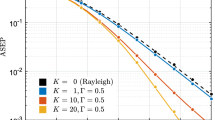Abstract
Excess loop delay in sigma–delta (\(\Sigma\Delta\)) modulators, especially by increasing the level of noise in signal bandwidth in continuous kind of them, leads to a dramatic decrease in their efficiency. In this paper, the error originated from the loop delay is calculated analytically and a new structure for sigma–delta modulators is presented based upon this calculation. This new structure can compensate the effect of loop-delay error completely independent of amount of delay. So by changing in loop delay during system working, the proposed structure has ability to consistent itself with new conditions and re-eliminate the error. This ability is independent of being multi-bit and the order of modulator. To evaluate the efficiency of the proposed method and the corresponding structure, first and second order modulators with capability of eliminating the error of loop delay, have been designed and simulated. All of simulations show the correctness of proposed analysis. Comparison of the proposed structures with the previous works shows the effectiveness of our technique.











Similar content being viewed by others
References
Schreier, R., & Temes, G. C. (2005). Understanding delta-sigma data converters. New York: IEEE.
Norsworthy, S., Schreier, R., & Temes, G. (1997). Delta-sigma data converters: Theory, design and simulation. New York: IEEE.
Ortmanns, M., & Gerfers, F. (2006). Continuous-time sigma–delta A/D conversion: Fundamentals, performance limits and robust implementations. New York: IEEE.
Cherry, J., & Snelgrove, W. (1999). Excess loop delay in continuous-time delta-sigma modulators. Circuits Systems II, 46, 376–389.
Shoaei, O. (1995). Continuous-time delta-sigma A/D converters for high speed applications. Ph.D. Thesis, Carleton University, Ottawa.
Gao, W., Shoaei, O., & Snelgrove, W. M. (1997). Excess loop delay effects in continuous-time delta sigma modulators and the compensation solution. In: Proceedings of IEEE International Symposium on Circuits and Systems (Vol. 1, p. 6568).
Shamsi, H., & Shoaei, O. (2004). Return to-zero feedback insertion in a continuous time delta-sigma modulator for excess loop delay compensation. IEICE Electronic Express, 1(18), 568574.
Benabes, P., Keramat, M., & Kielbasa, R. (1997). A methodology for designing continuous-time sigma–delta modulators. In: Proceedings of European Design and Test Conference (pp. 4650).
Fontaine, P., Mohieldin, A. N., & Bellaouar, A. (2005). A low-noise low-voltage CT \(\Delta\Sigma\) modulator with digital compensation of excess loop delay. In: Proceedings of IEEE International Solid-State Circuits Conference on Digital Technology Papers (Vol. 1, p. 498613).
El-Sankary, K., Alamdari, H. H., & El-Masry, E. I. (2009). An adaptive ELD compensation technique using a predictive comparator. IEEE Transactions on Circuits and Systems, 56-II(8), 619623.
Author information
Authors and Affiliations
Corresponding author
Rights and permissions
About this article
Cite this article
Deilam Salehi, M.M., Miyar Naimi, H. Excess loop delay cancellation in sigma–delta modulators. Analog Integr Circ Sig Process 79, 245–254 (2014). https://doi.org/10.1007/s10470-014-0270-8
Received:
Revised:
Accepted:
Published:
Issue Date:
DOI: https://doi.org/10.1007/s10470-014-0270-8




